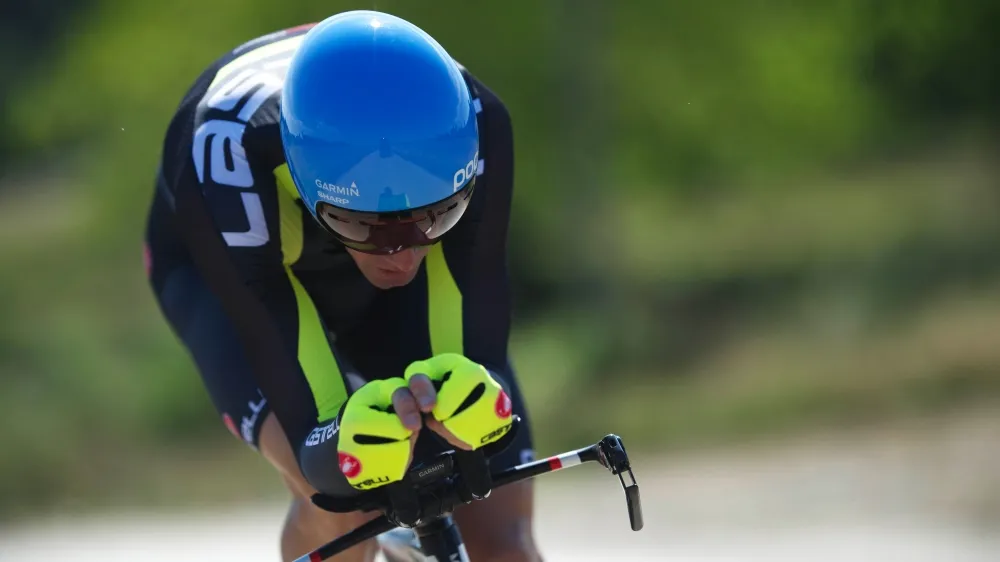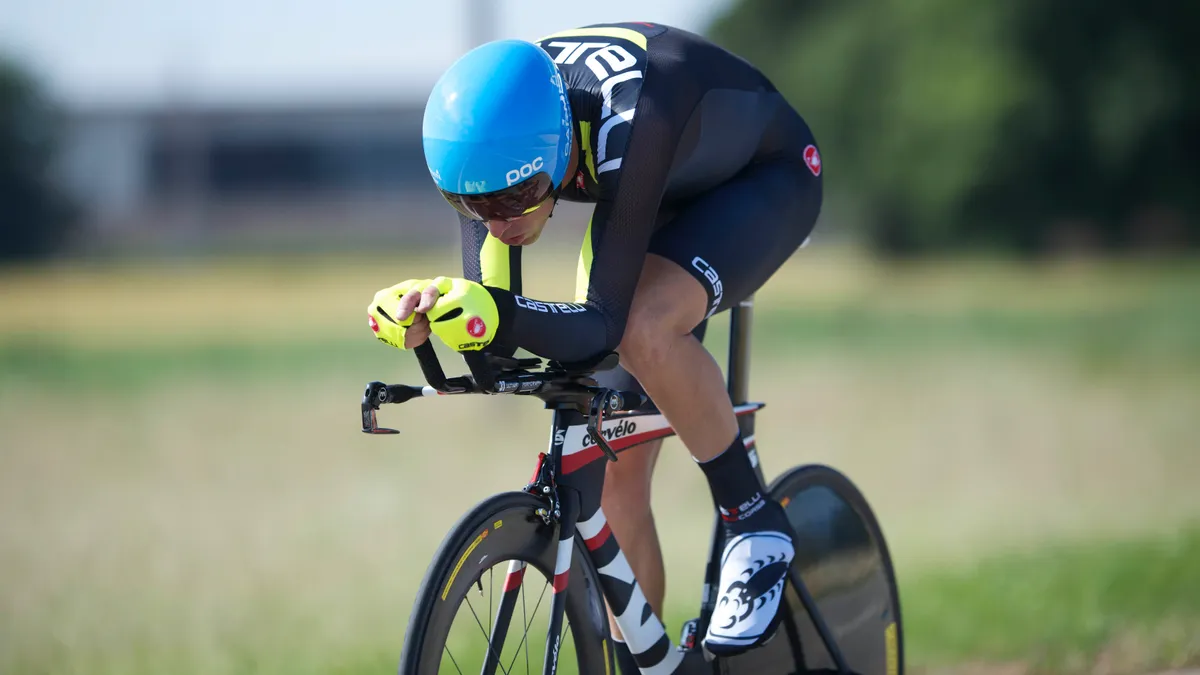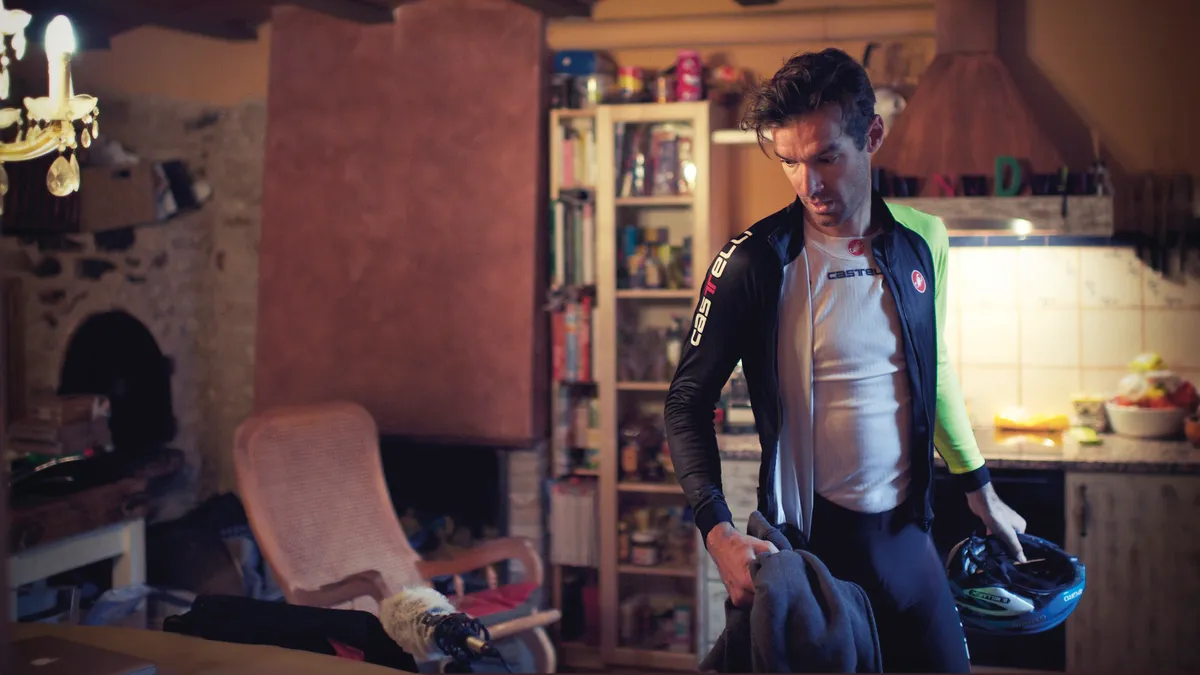This is a promoted post in association with David Millar and A1 Members.
A time trial is probably one of the easiest disciplines in bike racing to train for outside of track, because it’s possible to replicate the demands of a TT quite well during training sessions.
Unlike training for a road race, which is damn near impossible to recreate outside of the actual race day, everything can be structured and applied in your TT training sessions to prepare your body and mind for the particular event you’re targeting.
However, a large proportion of riders also compete in road and other cycling disciplines, and the specific training for TT has to be factored into their overall training plan. That plan has to be both developed and implemented with two unique contexts in mind: you, and the nature of time trial racing.
You can read any number of research papers and training articles on how to develop your time trial speed, but the vast majority boil down to the same thing. The main fitness component is primarily your Functional Threshold Power (FTP) – the maximum effort your system can sustain over your TT distance. Training for this is no great secret: it hurts a lot and there are only a few basic ways of doing it well.
However, much of this research and a lot of training programmes are based on the assumption of a controlled environment. Yes, some of this training can be done on a home trainer, or in a gym or lab, and this has certain advantages. Apart from being out of the weather, for example, very precise workouts can be done.
That said, both life and racing are messier than lab or home-trainer conditions, and you have to take your circumstances into account, as well as the varying demands in TT racing conditions.
null
We live and compete in dynamic rather than static environments – changing TT courses, and work and family demands – and it is essential that you learn to train for these changing contexts.
Even though I hadn’t a name for this kind of thinking when I was developing my training system as a professional, I found myself constantly asking, with each new training method, piece of equipment or racing strategy that was suggested: “But, will this work for my training and for me when competing in such-and-such event”?
With the input from the guys at A1 Coaching I am happy that this aspect of my system as a professional – contextual training – has to be the approach also taken by amateurs to get the best possible results. Your preparation will be unique to you – to your fitness level, work and lifestyle, age, goals, and other such variables. And, for it to work for TT, it has to contain certain essentials focused on the TT-specific racing context.
Therefore, with contextual training your approach is designed around your circumstances and the particular demands of your event. Much too often it’s the other way around – you are presented with an abstract training progamme with the expectation that you will conform to the demands of that.
As I said, the first variable to look at is you.
Context 1: your unique self
The first context is yourself and, for most, one of the main factors influencing training is available time.
When I turned professional training was all about "putting the kilometers in". Hours and hours of riding was the prescribed recipe for developing good form. However, that really started to change over the last 10 years of my career. As more and more science came into the sport we began to realize that doing very specific high intensity intervals over a shorter time period could often give you a better training adaptation.
Therefore, towards the latter part of my career I found myself doing much more race-specific workouts. While I had to balance road-racing with TT, I learned how certain workouts gave me the exact training adaptation I needed for my target TTs, while still contributing to my overall race programme.
These developments in science research brought some big potential advantages to the amateur because most didn’t have 20 hours per week to train. However, I say ‘potential advantages’ because it has been slow to filter down. Like all developments, there was a lot of resistance to new ways – I’ve met quite a bit of that in my day!
Even yet, I have good amateur riders ask me all the time: “How many hours should I be putting in”? As if this was the main determining factor to success.
This was why I found the guys from A1 Members so refreshing when we first teamed up. They have been beating the high-intensity drum for some time and were obviously passionate about bringing the cutting edge sports science to everyday amateur riders with busy lives.
A1’s team of coaches are supporting amateur riders day in, day out, and have a deep understanding of the complex demands they struggle to balance – they have had to adapt to contextual training in a different way than I did but it is the same basic approach.
So, for me to contribute to the amateur scene, the collaboration with A1 Coaching has been the perfect match of my experience and the application of science to the amateur context. That is what the A1 guys are good at. They have proven, over and over again, that the scientific methods which I had begun to use as a professional do work with amateurs and can produce phenomenal increases in fitness with less than eight hours training per week for the everyday rider.
Therefore, within your context of limited time you have to focus on quality sessions. By ‘quality’ I mean more than just intensity. I mean specifics: each section of each hour must be planned to bring a particular physiological or other training adaptation. If you are short on time you must, to quote A1’s Anthony Walsh, “embrace the intensity revolution”.
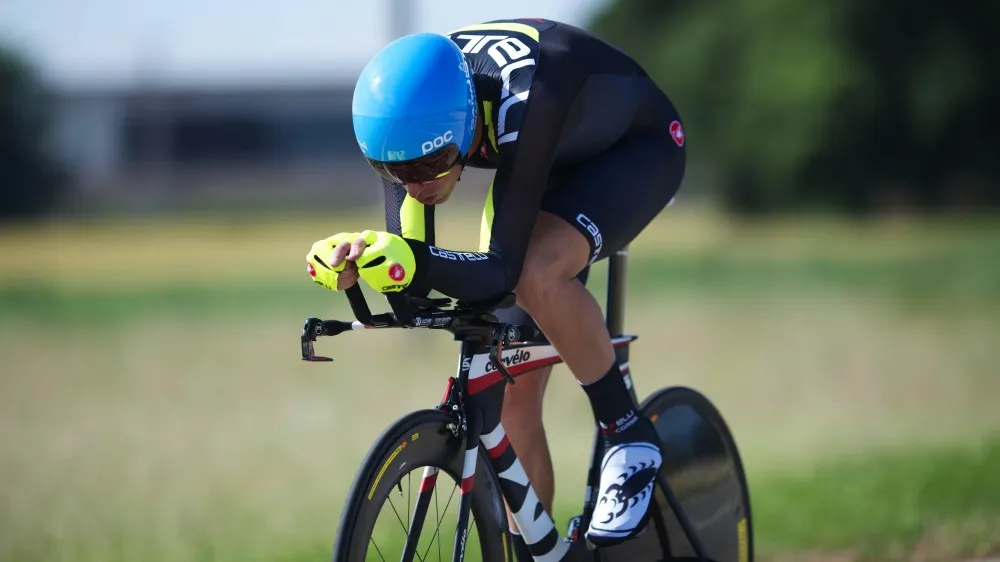
Context 2: TT-specific conditions and demands
The second context, on which that quality of training must also focus, is the nature of the TT event itself and how it differs from road-racing and other disciplines. As I have been stressing throughout this series, the TT is not a controlled or static environment as is so often suggested. You must train for the racing context and implement, under the stresses of racing, the other varying elements of the system that I have covered so far: position, cadence, pacing, and such like.
You will have figured out your TT position – or you are in the process of refining it – and have practiced pedaling efficiency. The home trainer in your shed, living room or under the porch, may have been your laboratory for these elements of your preparation.
However, you won’t to be racing on a home trainer but out on the road with constant variables and a barrage of sensory stimuli. There are changes in gradient, road surface and air resistance – more often than not wind buffeting you from every direction with changes in direction and shelter.
The additional sensory stimuli will blunt your judgement and processing capacity – cars and trucks, screaming legs and weakening core, sweat in your eyes and snot dripping from your nose. (Luckily, you won’t have the additional distraction of the team Director Sportive screaming at you from the team car behind!).
With all of this in mind, it’s essential that you train specifically for these contextual conditions. Whether you are a dedicated time triallist, or primarily a road racer who needs to do good TTs, you must incorporate these factors into your programme whether it is developed by yourself or a coach.
With all of this in mind, my system breaks these essentials down into three, basic key approaches.
‘The David Millar TT System’ is a fascinating 5-part series from which even the most experienced time-triallists will review how they do things. Millar is one of the top time triallists in the history of cycling and this series reveals the system which brought him there. Developed in conjunction with A1 Coaching, the system for TT success is broken down into five key elements which can be implemented by the everyday cyclist.
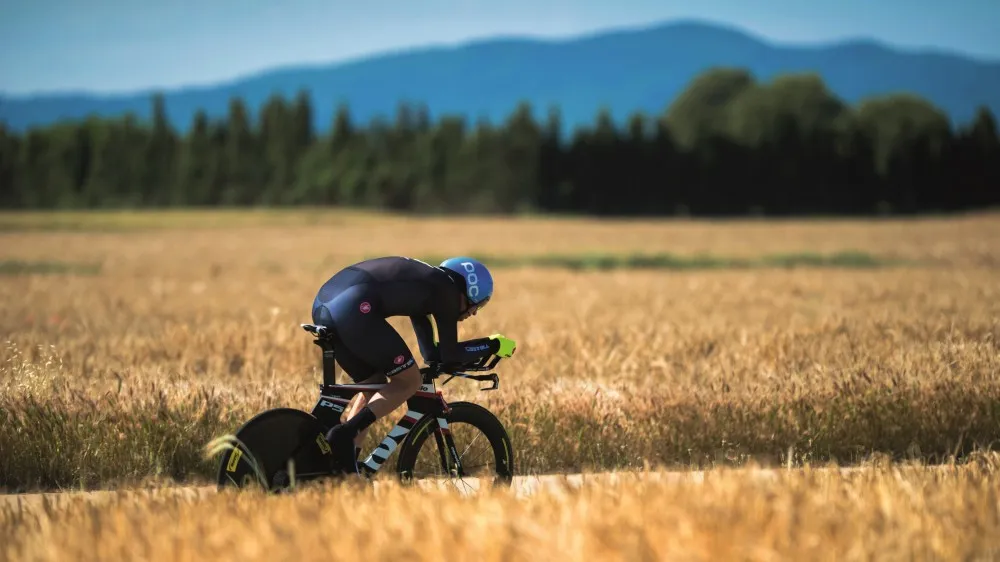
Essential 1: position training
As I have outlined, there will be constant fluctuations in power and cadence due to the constant adjustments you need to make, be it from gradient, road surface or wind.
Add in creeping fatigue. Your legs will leave you in no doubt of the effort but, less perceptibly, your core and upper body will also weaken and the scaffolding you have for putting the power through the legs will begin to flex and become less stable.
You can’t simulate these variations well on the home trainer: you must do it under race-load stresses, in the race-like environment.
I hope it’s clear at this stage that these sessions are not about hours on the bike – they are about quality. They are best done as intervals and their timing and effort will vary depending on the length of your event, your overall training programme, the overall time you have available, and so on. I will give some specific examples of sessions in the next post.
In position training sessions you must hone the quality of your position while under physiological race stress, and in the other varying environmental conditions. This will produce a number of essential training effects, in addition to improvements in your engine.
First, it will reveal any issues with your position that haven’t arisen from the initial setup or subsequent refining. You may find it’s fine for the first few intervals but, as fatigue sets in, niggles may start to appear. This will give you time to adjust, experiment, and adjust again.
Second, you will be training your body to hold that position from the point of view of both aerodynamics and core stability which is the platform for the transfer of power. Much cycling effort produces rotational forces – you apply effort on one side at a time and your body has to stabilize itself to counteract that force, more than once every second. The home trainer, with the bike secured, absorbs much of those forces and you don’t get the same training effect even if the load is similar.
Third, you will start to notice the aerodynamic effects of your position on speed. Whatever device you’re using to capture data, focus on only two parameters on the screen – speed and cadence. Play around with tiny tweaks to your position and cadences on different road segments and in different wind conditions.
See if the speed changes when you do alter these and start to register what works best for you under particular conditions. Never forget that speed is the most important variable and learn what is fastest for you (I have described in the last post how power data can be counter-productive in this respect because increased power does not necessarily mean increased speed if it compromises your aerodynamics).

Essential 2: pace control training
This is perhaps the most important part of any TT and an essential component of training. You can have the perfect position, completed all the physiological training, bought the flashiest bike and chosen your course, but if you can’t pace your effort correctly then you are not going to get the best time you are capable of. It may sound strange, yet it’s amazing how even the most experienced professionals can get this wrong.
Your pace control training – either specific sessions or built into other sessions – is not just about staring at a screen of numbers. It’s more about feeling what works for you and training yourself to listen and recognize what’s going on with your body.
In race conditions you need to be able to do this institutively and sub-consciously. Constantly trying to look at numbers on a small screen, do calculations and make adjustments, just won’t work well in the stresses and distractions of true racing conditions.
To get this skill internalized you need to practice it constantly and, come the adrenaline-fueled excitement and pain-sapping conditions of race day, you will trust your instincts and your pacing will be much more responsive and accurate.
In the last post I described how to segment the course and control your pacing accordingly. You have to practice doing this under load in these sessions (see the next post for an example) and this requires a lot of mental strength and conscious thinking to persist. But, for it to be a quality session, this is what it’s all about.
David Millar spent many years perfecting his time trialling to the point where he became one of the very best in the world. By thinking outside the box, and challenging conventional training methods, Millar learned new methods and approaches which helped him gain that edge in speed. Now collaborating with the people of A1 Coaching – who are also quickly getting to the top in their profession through innovative training methods – David reveals his ‘Millar Time Trial System’ which gives you the benefit of his years of work.
Essential 3: speed endurance training
This is the simplest but the most demanding of sessions. These will be the sessions you dread most on your training programme – or should be if you are doing them right!
These are purely about developing your engine – increasing your horse-power. To do this you have to stress the body in order to function efficiently at the required level. Done properly, they will give the biggest training effect.
Speed endurance will, of course, not be done in isolation. You will be incorporating the other two essentials and focus on your ability to keep in the most aerodynamic position and to control your pace to get the maximum benefit.
From this review of the three essential approaches I hope you will see that there is more to your TT training than riding for X number of minutes at Y effort – I notice that a lot of training programmes give this type of simplistic prescription.
These three essentials all build up together, each one a building block to the next. When you take these three contextual approaches and build them into your ongoing training programme they will all start to interlink and become internalized and intuitive.
Check back tomorrow for my final blog post in which I’ll give examples of some specific workouts and for a sum-up of my five-element TT system.
